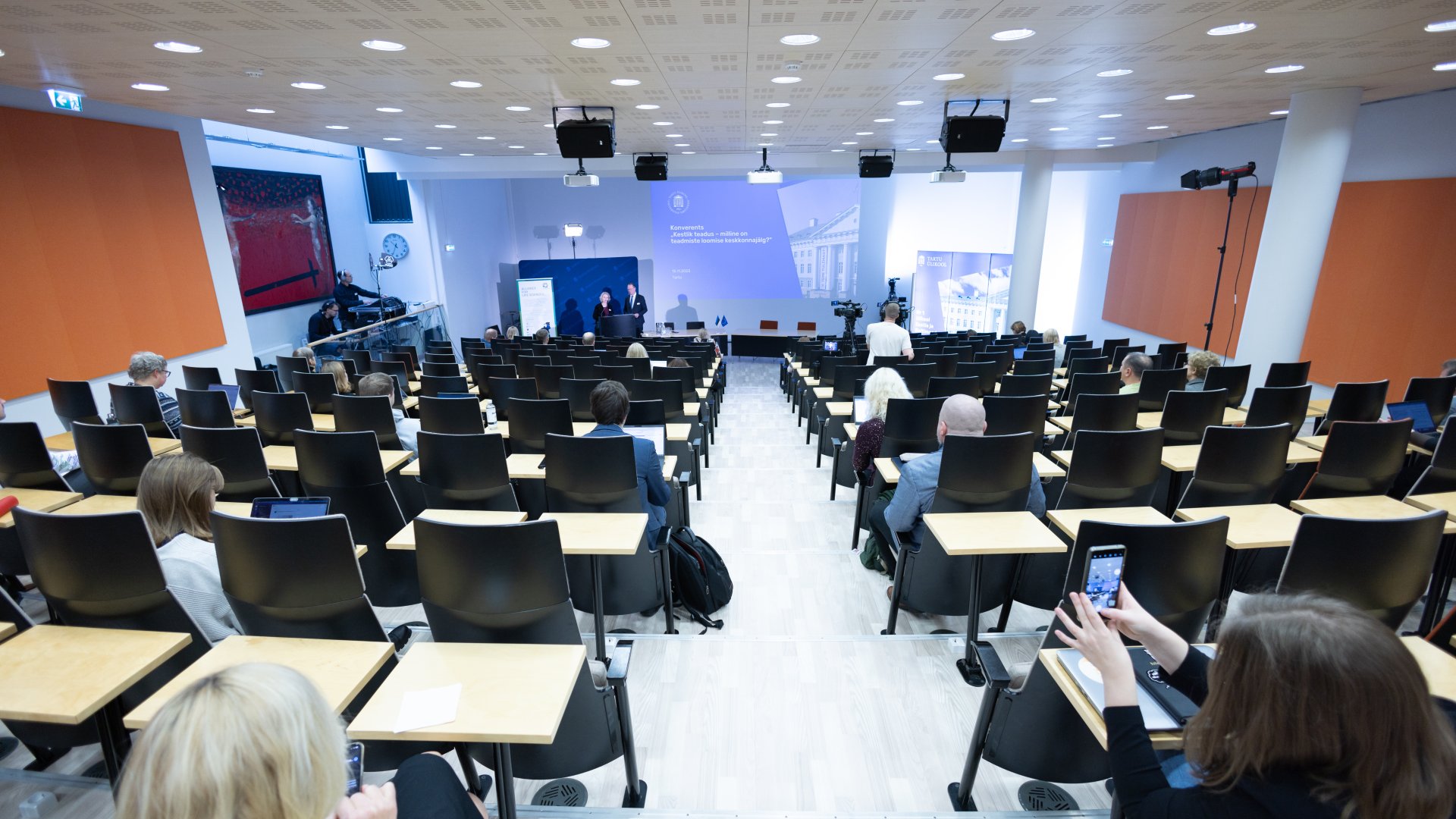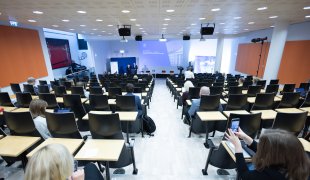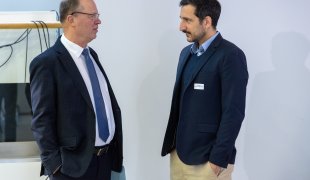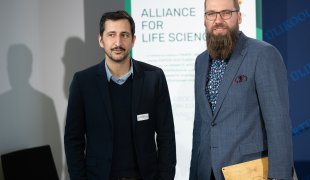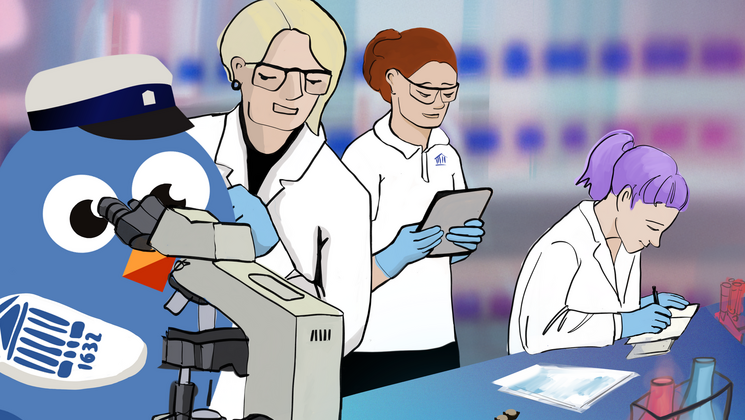Alliance4Life hosted the first conference on sustainable science in Estonia

On November 15, 2023 the conference on sustainable science titled “Sustainable Science – What is the Environmental Footprint of Scientific Knowledge Creation?” was organized by the Institute of Molecular and Cell Biology and the Centre for Sustainable Development, University of Tartu. This was the first conference focused on the environmental burden of creating scientific research itself among Estonian universities which brought together experts from all local major universities and research funders.
This was the second Estonian trigger event organized in the University of Tartu within the framework of the EU Horizon 2020 project, The Alliance for Life Sciences: From Strategies to Actions in Central and Eastern Europe. The whole-day event focused on the footprint of creating scientific knowledge which has not been discussed in Estonia among scientific organizations in public before. Scientists are expected to solve complex problems of climate change, but there is less talk about the environmental impact of scientific work itself, which also requires attention and consideration as science is extremely resource intensive.
In recent years, Estonian universities have started to pay more attention to organizational sustainability. The University of Tartu as the largest Estonian university is no exception: sustainability matters have been followed in tenders, University of Tartu museums received the Green Museum certificate, an environmental sustainability advisor was hired in spring 2023 and the organization’s sustainability policy is comprehensively worked out. The Allinace4Life as a consortia of life sciences has been a good example to the University of Tartu in green laboratory aspects as it has evoked to think about our present shortcomings and offered practices of other institutions to follow.
The moderators of the event were Margit Keller (Associate Professor in Social Communication, Head of the Centre for Sustainable Development, UT) and Toivo Maimets (Professor of Cell Biology, UT, Head of the Scientific Council of the Government of Estonia, Deputy-Chair of the Alliance4Life).
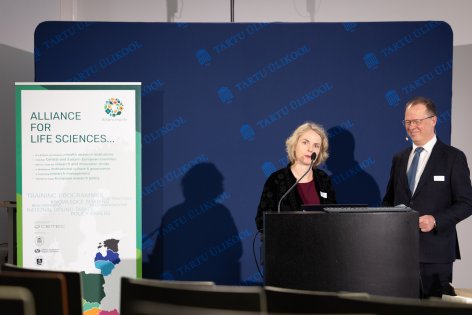
Moderators of the event: Margit Keller and Toivo Maimets
The environmental impact associated with knowledge creation can manifest, for example, in the energy consumption required to operate laboratory equipment or utilize computing power.
According to Toivo Maimets, a Professor of Cell Biology at the University of Tartu, both laboratory sciences and medical practices need to consider not only the energy costs but also the abundant single-use plastic waste, which is difficult to handle, and whose recycling options remain unexplored.
At some point we need to start thinking about what is worth of creating and preserving. As Albert Einstein already said, the fact that something can be explored doesn't mean it's worth exploring.
The environmental footprint also affects social sciences, humanities, and archival work, including the preservation of national culture and its heritage. Is it possible to conduct more sustainable scientific research and to think about the scientific process more broadly, not just about creating another amount of data? ─ this is what the conference encouraged to think about.
The environmental footprint of science begins to form already at the stage of formulating research questions. It's not just about how efficiently we conduct research, but also what and why we study. As scientists, we don't engage in self-analysis of our work processes very much.
These questions concern not only scientists and research institutions but also increasingly research funders.
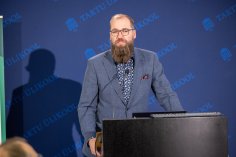
The conference was opened by Professor Tõnu Esko, Vice Rector for Development in the University of Tartu. In his opening words Professor Esko expressed the hope that the negativity caused by scientific research on the environment would be several times smaller than the positive search for solutions. He also stressed that as the only national university in Estonia, the University of Tartu has on the one hand the responsibility to think more broadly, and on the other, it is onIy positive that we have also started to consider the cost at which one scientific paper or data collection has been created.
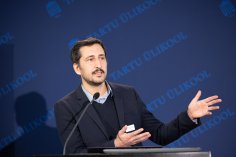
The key-note speaker Martin Farley, Director of Green Lab Associates and the former Head of Sustainable Science at University College London (UCL), entitled his presentation on the possibilities of more environmentally friendly and cost-effective laboratory science “The sustainability of science – what will net-zero research resemble?”.
Farley, with the background of stem-cell research, was the UK's and Europe’s first full-time sustainable laboratory specialist at the University of Edinburgh. Later he moved to London where he founded Green Lab Associates, while establishing the sustainable labs program at King's College London where he was recognized with the Green Gown – Sustainability Professional award. Today he is the Director of Green Lab Associates, consults a variety of institutions, regularly speaks, and teaches on the topic. He has also written on the topic in the pages of the journal Nature.
A 2014 study estimated that scientific output doubles every 9 years. Science is growing very fast and its resource intensity is damaging to the environment. Some examples: one ultra freezer uses as much energy in a year as an average UK household uses in a year; laboratories are very energy consuming – before the energy crises an average research institute in London spent 15 million pounds per energy in a year, after the energy crisis it is 25 M pounds – most of it goes to laboratories to ventilate, heat and cool down, to energy capacity to keep the equipment running, relatively small amount to lights; in addition to data centers and servers to storage all the data scientists produce every day.
The net-zero research includes however so much more than just the energy consumption. It is pretty clear that it starts already in the planning and construction phase of the buildings, but over 80% of the CO2 emissions in the UCL come from purchases and products that scientists buy every day.
The carbon emission of science is difficult to measure compared for instance to the travel sector. In life sciences we have life-cycle assessment in some things but we are missing them in many other. It is all about what we explore and why in science and how we buy in science laboratories, why we buy and how environmentally friendly are our purchases and packages. But how to estimate it and feel the balance points? We can estimate the environmental efficiency of household machines but how to buy the most environmentally friendly ultra low freezer? What about storage temperatures? May be we should use the pipette tips washing machine for non-filter tips instead of buying constantly new tips or consider the use of a single use mouse cage in an animal facility? May be we should calibrate the pipettes more frequently instead of buying new ones? What does this bring along and how to measure the environmental burden of one or another mode of operation? These are the questions people working in Green Lab Associates ask themselves every day to take steps that help to make the laboratory environments as sustainable as possible, saving money, reducing pollution, and maximizing research potential.
Still, we do not know the answers to many of these questions, like the balance point of single use plastic versus reusable, the CO2 emissions of scientific pathways, yet. There are funding calls open to explore these topics. The reality is that if you don't want to be sustainable, nobody pressures you to care about the environment. UCL has created the Laboratory Efficiency Assessment Framework (LEAF) to globally consolidate laboratories and help them to improve sustainability and efficiency. Several other European countries have founded their networks as well, for example Green Labs Netherlands, Green Labs Austria, Irish Green labs. Sustainable European Laboratories (SELs) is a umbrella organization to pull them together and promote good practice to others.
What about the future? Scientists are very competitive for their time and asking people to concentrate on another aspect, sustainable science, is difficult. Every institution should figure out it's own policy and direct scientists with clear messages.
According to Martin Farley it is the funding agencies of research who can shape the research directions, operations, methods and it also are the suppliers who can do it. Countries can start their own green lab national network or join the existing one (e.g. LEAF). The communicating of success stories in laboratory environmental friendliness is extremely important. Also, the engineers and supporting technical staff is going to play a very important role in the change towards net-zero research.
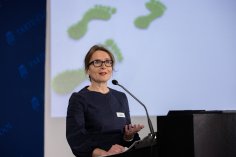
Raili Marling, Professor of English Studies at the University of Tartu, looked in her talk "How to avoid academic waste in a competitive academic landscape?" beyond experimental sciences, focusing on the substantive sustainability of science and the significant methodological footprint in the context of qualitative research in the humanities and social sciences.
Every scientific work has it's footprint. In humanitarian and social sciences academic waste is created by collecting and preserving data, conducting fieldwork, publishing and presenting data in seminars and conferences. The cost and burden of such activity versus potential new knowledge was the main topic addressed in this presentation. In addition we should keep in mind that one important scientific resource is the human capital (e.g. the scientific personnel itself) which is often misused.
Scientists usually produce "more science and even more data" for each single topic and publication without thinking always about the sustainable consequences. In other words, rapid science with a lot of attempts to publish and get ready as much project applications as possible is a reality. But enough amount of data has probably already been created in previous studies which can be reused, analyzed in a different way or enriched. Only a small amount of scientific work results in a scientific paper, the rest is not published and remains often unused.
Under-analyzed data as knowledge waste should be brought to the forefront. The interdisciplinary approach has to be supported more as scientists from neighboring fields can share their data and take the utmost from the existing data.
Data Management Plan should be accompanied with Data Waste Plan explaining how scientist cross- and reuse already previously collected data. It is also worth considering to add an environmental label to each publication.
Scientists need more time to think about their science, also about using data. Science will never be net-zero but several measures, including respectful attitude towards human resource, will make it more sustainable.
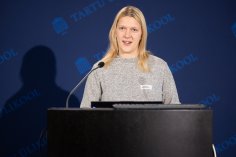
Krista Kupits, Advisor in the Environmental Management Department, Estonian Ministry of Climate, talked about the principles of circular economy supporting the sustainable research.
In theory, circular economy as an economic model which turns sourcing raw materials, producing, packaging, transporting and using the products thoughtful and sustainable, is quite simple. If that's the case, why is it still not being used enough? In other words, circular economy is all about rethinking production and consumption so that our materials are in use for as long as possible.
A scientist as an individual person, as an individual researcher, as a worker in a research team, as a member of a research institute and the institute as a part of the university are all different levels in sense of circular economy and at all these levels it is possible to operate more sustainably, also in wet lab.
Krista Kupits focused precisely on how to actually implement the practices heard about in the previous presentations and also introduced some good examples of LIFE programme (EU's funding instrument for the environment and climate action) projects applied in Estonia and encouraged the researchers to think about how closely they monitor the life cycle of just one of their operational processes in the lab and how often they consider introducing some changes in it. The speaker argued about the general recipe of circular economy - don't produce just for the sake of production, and if produce - do not do significant harm to the environment, and invited the audience to consider whether it can be applied in science.
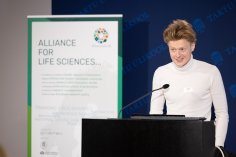
Jaan Vihalemm, Researcher in biomining company BiotaTec Ltd, one of the first Doctoral Students in the University of Tartu undergoing the industrial doctoral programme, introduced a very relevant subject - biomining, which is "mining" without actual mining but mining (extracting metals from ores and other solid materials) with the help of micro-organisms (bacteria, archae, fungi or plants). This process is also called bioleaching.
The mission of the company is to develop biomining technologies to help industry to move towards carbon-neutral future and to increase the availability of critical raw materials (gold, silver, platinum etc.) from local low-grade ores and wastes, especially from electronic waste (E-waste).
Who hasn't produced an electronic waste? Everybody has and everybody produces as e-waste growth is directly linked to economic growth and well-being. The better we do, the more industrialized and urbanized we are, the more electronic waste is generated worldwide. Smart devices are used for about 2.5 years, electronic household devices, on average, for 5 years, and in case of few repair options they are discarded after that and become e-waste.
In 2014, each person generated 7 kg of e-waste per year, in Europe the number was 16 kg per year. E-waste is the fastest-growing waste sector globally where only 17% of waste is recycled worldwide. Of the e-waste produced in 2019, 83% has not entered the recycling stream. Instead, e-waste is often exported to developing countries, where it may be dismantled, buried, or discarded, never counted and reported as should.
Urban mining has become an important part of circular economy. E-waste is a worth source of critical raw material needed in sustainable energy creation (e.g. in windmills) for implementing the green transition. E-waste also contains several hazardous substances such as mercury and many others, and that is also one reason why the uncontrolled disposal of e-waste must be prevented from entering the environment. The hazardous substances remain in the environment active for decades causing serious health and environmental problems. Bioleaching metals from e-waste is the best method to recycle electronic waste done at normal pressure and temperature with a low energy cost and low CO2 footprint without creating noise, pollution and creating itself a low amount of wastes. Bioleaching also generates positive feelings in people as the community is not against it as in the case of conventional mining.
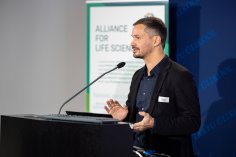
Andre Visse, Chief Technology Officer in Telia Eesti, spoke about the IT sector footprint.
Telia is the Estonian telecommunications operator with the longest history inspired by the possibility of using technology to make people’s lives easier and more convenient. The company has Nordic background but it is leading the ICT market in both Finland and the Baltics. In these days, the company additionally develops activities in two broad areas - to fight with digital crime (as criminal activity moves from streets to the internet) and to bridge the digital gap between generations (as elderly people are usually not as aware of the digital possibilities and dangers as the young).
The company has set the target to be zero CO2 and zero waste by 2030 and promotes this understanding among it's employees, partners and clients. Starting with these activities in 2018 the company had no idea about the size of it's environmental burden (footprint) or how to achieve the goals set. By today the target has been corrected, to reduce the company's zero-emissions by 90% by 2030 as it is not realistic to reach more. The company has many steps to reach this goal, using renewable energy, directing over 90% of the material into circulation and circulation process of used devices.
We were one of the first one's in Estonia measuring our footprint all along the production chain based on GHG protocol. We discovered that doing business environmentally friendly is not more expensive for us. We also got to know that 98% of our footprint is generated outside the company by the producers, logistics and final users.
New technological possibilities also conceal several new risks, many of them have to do with comfort. For example, people want to use 5G network and expect it's coverage all over the country to conveniently share large files with each other without acknowledging the fact that the overall consumption of energy increases. The footprint of ICT exceeds already today the footprint of the whole aviation sector and is as big as the energy consumption of 200 M developed households. In the next decade the electric energy growth in ICT footprint will mostly come from networks (especially mobile networks) and data centers.
In 2022 the company's CO2 footprint was 74 000 tons of CO2E meaning that 1% of Estonia's forests functioned to neutralize the footprint of only our products and services.
Telia Eesti has given several good sustainability examples to it's clients and the society as a whole, for instance the company initiated the once a year digital cleanup day in Estonia followed by many companies and institutions. The next cleanup, the sixth digital cleanup day in Estonia, will be on January 26, 2024. The company provides advice to other companies on how to measure their carbon footprint. The company persuades it's clients to return old devices and reutilize well-maintained used one's. However, people in Estonia do not yet consider sustainable IT consumption important, so there is a lot of convincing to do.
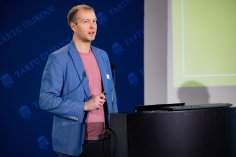
Keit Nestor, Head of Operations in Paikre Waste Management Company clearly demonstrated in his presentation "The environmental footprint of waste sector" what actually ends up at the Estonian waste facility. Paikre Waste Management Company in south-western part of the country is the only waste management company sorting also mixed municipal waste in Estonia.
Waste collection is still relatively inexpensive in Estonia, and people's awareness to consume wisely and sort waste is not as good as it should be. Landfilling waste is the poorest practice, incineration comes next and then recycling. Incineration and landfilling are relatively similar in terms of greenhouse gas emissions. The company has improved in collecting bio-waste, managing to avoid methane formation.
Paikre Waste Management collects approximately 500,000 tons of municipal waste in Estonia, including mixed waste out of which 40% is sorted. 50% of collected mixed waste is still packaging waste which should be collected separately. The recycling capability is only 28% of all this, 47% of the waste going into energy creation and the rest (25-30%) being landfilled, which is the main area for improvement.
Another big problem in Estonia is food-waste. Estonia discards 84 tons of food annually, with a total value of 160 million euros per year, including stores, restaurants, and homes. This can be turned into compost, creating nutrient-rich soil. From the waste company's view there is a lot of improvement also concerning manufacturers: when packaging, consider the recyclability of the packaging and make use of production waste. Even in science laboratories, clean plastic waste can be processed if it is collected sensibly.
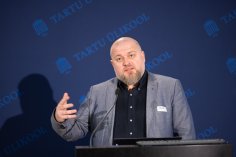
Jaanus Terasmaa, Professor of Ecohydrology, Tallinn University, concluded in his thought provoking presentation "Can science be sustainable at all?" that the mankind has reached the end of abundance. We exceed the six planet's tolerance thresholds out of nine. No matter how fast the economies and societies grow, we cannot grow beyond the limits of the environment. The economic growth, regardless of the population of 8 billion people on Earth, has exceeded the population growth by 27 times.
There cannot be as many children on Earth as there are today, ever again, as we have run out of resources.
Professor Terasmaa presented several examples that were developed with a noble idea to make things better and more efficient, but unfortunately the opposite effect was achieved, those new solutions started to be used by people many times more resulting with a negative impact. It is a common knowledge that the ocean is full of plastic. Only in 2023 nearly 68 billion tons of plastic waste will be added to the environment. Ironically the plastic bags were developed in 1959 in Sweden to prevent cutting trees and avoid making paper bags.
A more recent example, incandescent light bulbs were replaced with LED bulbs which are 80% more energy-efficient, but their impact on lightning usage despite the energy price has been the opposite. People keep the lights on for a longer time because the bulbs are so energy-efficient and this has also resulted in a significant amount of light pollution on buildings, streets, pathways, in parks and courtyards which we can witness every day ourselves. Similar examples can be taken from scientific research ─ with the emergence of new methods and products we keep producing and consuming even more.
In 1865 the English economist William Stanley Jevons described the Jevons' paradox, perhaps the most widely known paradox in environmental economics. Technological progress increases the efficiency of resource utilization but also leads to an increase in overall consumption and environmental impact, not savings.
The human nature is set to function in a way that if some resource is available and cheap, then it means that we can consume more of it. Without social innovation and awareness the solution will not occur. Technological innovation alone is harmful to the environment.
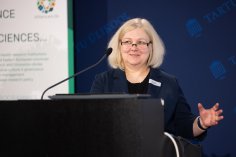
Reet Mägi, Head of the University of Tartu Natural History Museum and Botanical Garden, Department of Exhibitions and Nature Education, spoke about "Green Museums in the University of Tartu." In May, 2023 University of Tartu Museums received the Green Museum certificate for promoting sustainable development.
The new definition of museums by ICOM in 2022 stipulates that a museum also researches heritage and fosters sustainability. The definition of a museum was not amended accidentally. After several discussions ICOM reached a common opinion that it only makes sense to collect things if they are also studied.
Why is a separate environmental management system needed for museums? We already have a Green Office and a Green School. For Green Museums, elements were taken from these two and activities directed towards the audience, which museums perform, added. The Green Museums Program in Estonia was completed in 2021 and the first museum, Kumu Art Museum, received the Green Museum certificate in 2022. The Green Museum Program in other words is an environmental management system for museums. It is mostly based on the model of Green Office, but activities directed towards clients and tourists are taken from the model of Green School. The idea of Green Museum, as museums differ in size, topic, location, is that each museum creates its own system within it, but follows common principles.
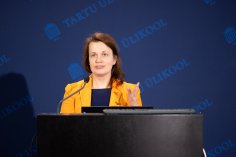
Mari-Liis Štrik-Ott, Environmental Sustainability Adviser, University of Tartu, introduced the Environmental Overview of the University of Tartu.
The presentation included the results of the first Environmental Overview of the University of Tartu (2019-2022), the overview of the carbon footprint of the university (2019-2022) and the introduction to the environmental management system which the university wants to establish. The overview covers all 4 faculties and 3 colleges of the university, administrative units, but it does not cover the Sports Club of the UT, Student Village and Student House and university affiliated companies.
The guidance for the overview was provided by the Strategic Plan of the university, the Development Strategy Tartu 2030 and the environmental permits of the university. At present, the university holds 9 valid environmental permits, 7 of which are radiation permits, for research and training. The University of Tartu has already taken several steps on the way to be more sustainable: the good example from the museum and the establishment of the Sustainable Development Center in 2022 to serve society and raise awareness, implementation of environmentally friendly public procurement procedures since 2022 but there is a lot to do yet and the cooperation among universities is essential.
One good example regarding energy efficiency is the fresh measure by the Estonian Ministry of Education and Research to support universities in making buildings more energy-efficient. The University of Tartu also received 4.5 million euros from this initiative in 2023, added 6 million euros self-financing and improved the energy efficiency of several buildings.
The Environmental Overview of the University of Tartu in last 4 years highlighted that both construction activities and energy use are the most resource-intensive for the university. Transitioning to several renewable energy sources is necessary where it is possible.
The workshop was led by Krista Kupits
(Advisor from the Circular Economy Department of the Ministry of Climate in Estonia)
In the workshop the attendees received practical tips for reducing the environmental impact of offices or organizations. The workshop provided several suggestions about the day-to-day management of the organization, which help to improve the environmental and economic activities and reduce the risks and costs related to the environment, occupational health and safety.
Examples were given on how to reduce the footprint in the office or in lab environment. The participants discussed actively about the future perspectives of the circular economy regulations and their possible implementations in everyday life.
Photos from the workshop Ermo Leuska, University of Tartu
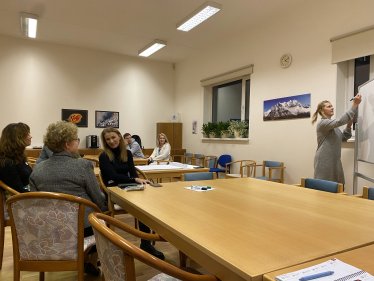
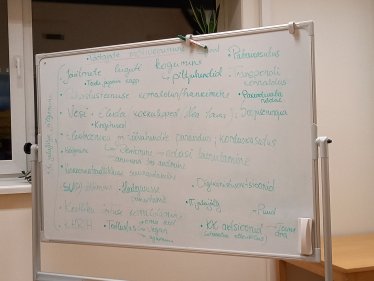
The workshop was led by Reet Mägi
(Head of the University of Tartu Natural History Museum and Botanical Garden, Department of Exhibitions and Nature Education)
The workshop concentrated on science popularization activities and their sustainability. Science outreach is a part of everyday life in research institutes encompassing the submission of guests, organizing events for public, exhibiting scientific works etc.
The participants shared their practical tips on how to reduce costs and be sustainable:
- avoid preparing name-labels and ask participants to use one of their old ones;
- avoid any event materials on paper and prepare only online materials;
- ask participants to use their own water of coffee cups and use tap water;
- prefer vegetarian and local food;
- reuse furniture and exhibition stands – make them from plywood instead of PVC or kapa-plates or even better, do not use the stands at all, use the walls and hooks and repaint the walls in the places of labels;
- recycle as most of wastes as possible;
- do not make gifts to the speakers – the best gift is a gift which was never planned, made and handed over!
Organizing conferences and seminars in this manner may reduce external glamour, but in terms of content, events do not suffer. It is extremely important to educate your audience.
In 2024, Tartu is the European Capital of Culture and the city has developed a guideline for organizing sustainable events which is shared with the public to create awareness. This guideline was introduced and it was agreed that it is a very good example to organize also science popularization events. The guideline includes a pre-event what-to-do-list and a calculator on how to measure the footprint of the event afterwards.
Photo from the workshop: Ermo Leuska, University of Tartu
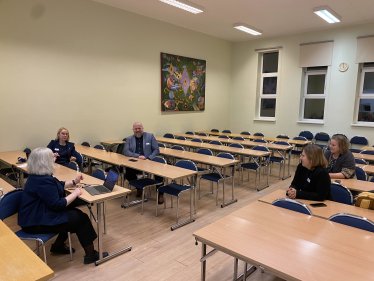
During the conference, it was possible to visit a sustainable art exhibition at the Omicum gallery.
From November 13 to December 11 the exhibition on sustainable art entitled "Two couples", the authors of which are two artist couples - Tuuli Puhvel and Eero Ijavoinen and Resa and Margus Tiitsmaa (Sorge), is exhibited.
|
Image
|
Image
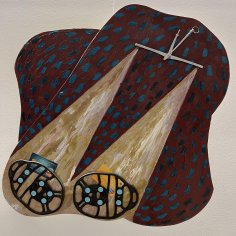
|
|
Image
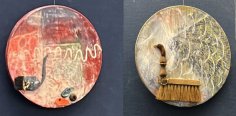
|
Image
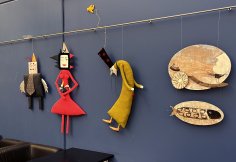
|
Photos of the pieces of art: Sulev Kuuse, University of Tartu
The exhibition in the newspaper Tartu Postimees, 17.11.2023
The working language of the conference, except the key-note presentation, was Estonian.
The recording of the event was made by the University of Tartu Television.
The recording of the key-note speaker, Martin Farley.
The programme of the conference.
All photos if not marked differently: Andres Tennus, University of Tartu
In Tartu, discussions are held on the environmental impact of science and possibilities for its reduction (Newspaper Tartu Postimees; 6.11.2023, in Estonian)
The scientists discuss about the environmental impact of science and how to reduce it (Newspaper Postimees; 7.11.2023; in Estonian)
Estonian scientists are just beginning to consider their environmental footprint (News Poral Novaator.ee; 17.11.2023, in Estonian)
Estonian radio Vikerraadio, programme Päevakaja (19.11.2023 at 18:00; starting from 10:36 until 13:00, in Estonian)
Martin Farley: to reduce the environmental footprint of laboratory science we need common standards (webpage of the University of Tartu, news, 28.11.2023, in Estonian)
Martin Farley: common standards are needed to reduce the environmental impact of laboratory research (webpage of the University of Tartu, news, 28.11.2023, in English)
The methodological footprint of science (Newspaper Sirp: 8.12.2023; in Estonian), written by professor Raili Marling
Good science can be done without harming the planet Universitas Tartuensis (2024 No 1 (Febr)), interview with the keynote speaker Martin Farley (the interview is translated into Estonian)


